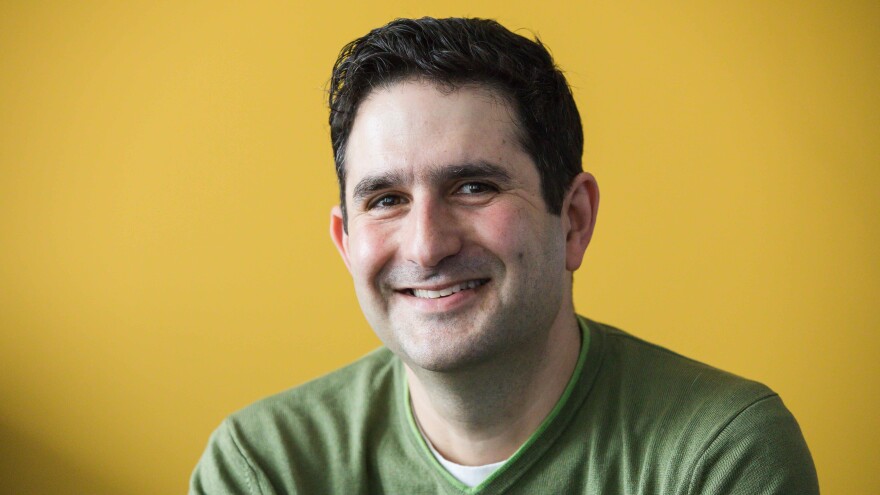BETHLEHEM, Pa. — Your clue: it’s the 14-letter word that describes a person who is skilled in creating or solving crossword puzzles.
If you're stumped, you could always ask for advice from Lehigh University’s Larry Snyder.
Just last month, Snyder, Lehigh's deputy provost for faculty affairs, had one of his original crosswords published in the bastion of word puzzles, the New York Times.
It's a rather rare feat — the New York Times gets up to 200 crossword submissions a week, and only seven are published.
So how did an amateur puzzle-lover make it to the big leagues of crossword connoisseurs?
From 'wordplay' to wordsmith
It all started in childhood when Snyder became enamored of puzzles, especially those found in the Dell Logic Puzzle books. Over the years, that love expanded.
“So I've always been into crossword puzzles," Snyder said. "I really started getting into it in earnest sometime during the pandemic.
"I have a friend who is an avid crossword puzzle solver on the New York Times. I was always just kind of solving the puzzles that are freely available. And she was like, ’Look, just spend the $40 a year get the subscription to the Times crosswords and do as many as you want.’
"And I did.”
Over time, Snyder said, he familiarized himself with the inside baseball of crosswords, becoming increasingly adept at solving puzzles every day.
While Snyder became familiar with the process of assembling crosswords, though, at the time, he said, his original creations weren’t quite up to par.
Snyder pointed out that with each New York Times crossword, there is a corresponding column called “Word Play,” which discusses clues for the day’s puzzle, in addition to the person who created the game.
“And I was reading one of those, and it said something like, ‘Oh, this is the 68th new debut constructor this year.' And I realized, ‘Oh, like, just normal people can submit crossword puzzles to the New York Times.’
"I had assumed that they just had a roster of people that write them, and that was it."
“I saw the email and I immediately called my wife, and I think she was freaked out like, ‘Why is he calling? He doesn't usually call into the supermarket.’ And she I was hugely excited.”Larry Snyder, crossword puzzle creator and deputy provost for faculty affairs at Lehigh University
“So I figured I would try, and there are lots of resources online about how to learn how to do it. And I wrote some I submitted some to the Times.
"When I look back at now, they were really terrible. But, you know, I got better. I got help from other more experienced constructors. I submitted puzzles to other newspapers and outlets, and some of those got accepted.”
At that point, Snyder said, he figured he could take a shot at submitting to the New York Times, and on Feb. 23, 2024, his puzzle was published.
“I was beyond excited," he said. "It was a couple days before Thanksgiving, and we had friends coming for Thanksgiving, so I was heading to the supermarket to do our shopping.
"And I checked my email when I pulled into the parking lot of the supermarket. I saw the email and I immediately called my wife, and I think she was freaked out like, ‘Why is he calling? He doesn't usually call into the supermarket.’
"I was hugely excited.”
Puzzling themes
Snyder explained his New York Times submission was a theme-less puzzle, which tends to start with one or two “seed entries,” or particular words the constructor wants to include.
Some constructors prefer to begin with the shape of their grid, establishing where black blocks will go.
Themed puzzles can be trickier, and often use wordplay and humor, extending beyond a simple collection of words that relate to one another.
“There are space limits, but I don't tend to think about them too much, just because there's a pretty clear convention for how long clues can be."Larry Snyder, Lehigh University's deputy provost for faculty affairs
Symmetry is important, as “there’s a lot of care that goes into choosing the themed entries, and then those go into the grid, and then you would add the black squares and fill in the rest,” Snyder said.
It takes some trial and error, Snyder said, but it can be an entertaining endeavor.
For his puzzle, Snyder drew inspiration from the world of art, particularly M.C. Escher's “Relativity,” featuring myriad staircases crisscrossing in a labyrinth.
He went from building his grid to filling in the longer entries, followed by the shorter entries, and then the clues.
“There are space limits, but I don't tend to think about them too much, just because there's a pretty clear convention for how long clues can be," Snyder said.
"You're always just thinking in those kinds of short snippets.So for me, I tried to come up with some kind of clever wordplay for some of them.”
Snyder said that as a constructor, “you want to have enough variety in the clues so that it doesn’t feel like the solver is just doing the same thing.”
Crosswordese
One tricky element while assembling a puzzle is the use of “glue,” or particular words that often appear in crosswords. Snyder said “every crossword puzzle constructor tries to avoid those words to the extent it’s possible.”
Some of those terms are common, and simply present an easy way to weave other words into the puzzle.
“’Aloe’ isn't going to kill a grid, but there are other words that are basically so obscure anywhere else other than crosswords, that most editors would say, ‘No, you can't be in here just because it helps make the section hold together,’” Snyder said.
A prime example is “etui,” a French term for a small ornamental case.
“It has just become the archetype in the crossword world of crosswordese, because no one uses that word, but it would be very convenient to use it in most puzzles," Snyder said.
"So at this point, puzzles won't use it, because it's just so obvious as crosswordese. But when I looked back at my first crossword puzzle that I submitted to the New York Times, it had that word in there.
"I'm sure that was just a red flag to the editors that this person just doesn't know what they're doing."Larry Snyder, Lehigh University's deputy provost for faculty affairs
"And I'm sure that was just a red flag to the editors that this person just doesn't know what they're doing,” Snyder said with a laugh.
According to Snyder, specialty software — such as Crossfire or Crossword Labs — is integral to modern puzzle-making, as certain programs can help the constructor find more interesting words to accomplish a theme or pattern for a puzzle.
“Whereas if you were doing everything by hand, you just are so much more constrained that it's hard to make things sparkle," Snyder said.
"Because in order to make things sparkle, you have to make huge sacrifices in other sections.”
Words of wisdom for enthusiasts
Snyder said aspiring crossword constructors can jump into the game rather easily these days, as there are several great online options — including the software mentioned above, and a New York Times guide.
There also are numerous online communities for constructors “who tend to be very generous and supportive of one another,” Snyder said.
"If I've been working at night, as I often do, it's a good way to kind of turn off the work brain and just focus on something relatively small."Larry Snyder, Lehigh University's deputy provost for faculty affairs
“I'm a member of Discord server called Crosscord, where a lot of constructors and solvers hang out and people there will solve your puzzles or give you advice about whether a theme seems like it would work," he said.
"Or even whether a given word is likely to fly with a given newspaper, for example. And that's been really helpful for me — that's probably the main way that I went from being totally incompetent to at least competent enough to get a puzzle accepted here and there.”
When it comes to published pieces, Snyder is being awfully humble — beyond the New York Times, he soon will have puzzles in the Philadelphia Inquirer, the Los Angeles Times and USA Today.
Ever a cruciverbalist — that’s the answer to the opening question, by the way — Snyder still enjoys kicking back and working out a good New York Times crossword to unwind.
“I usually solve them on my phone, often right before I go to bed. I find it to be a good way to kind of calm down my mind a little bit," he said.
"If I've been working at night, as I often do, it's a good way to kind of turn off the work brain and just focus on something relatively small.
"The New York Times releases its weekday puzzles at 10 p.m. for the next day, so often at 10 or 10:30, I'll pull up the app and, and work on tomorrow's puzzle."


